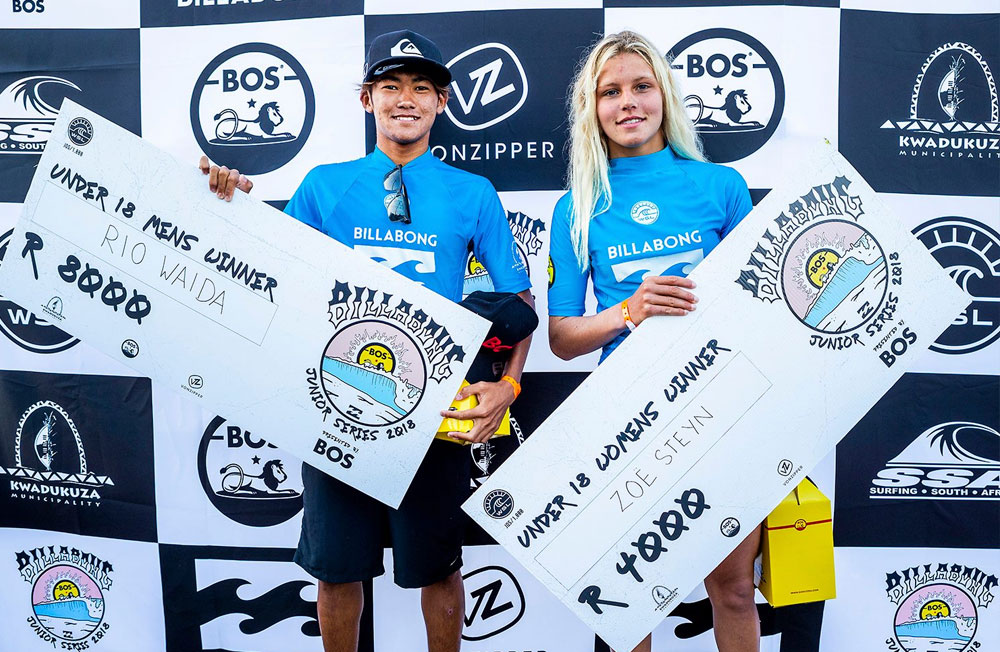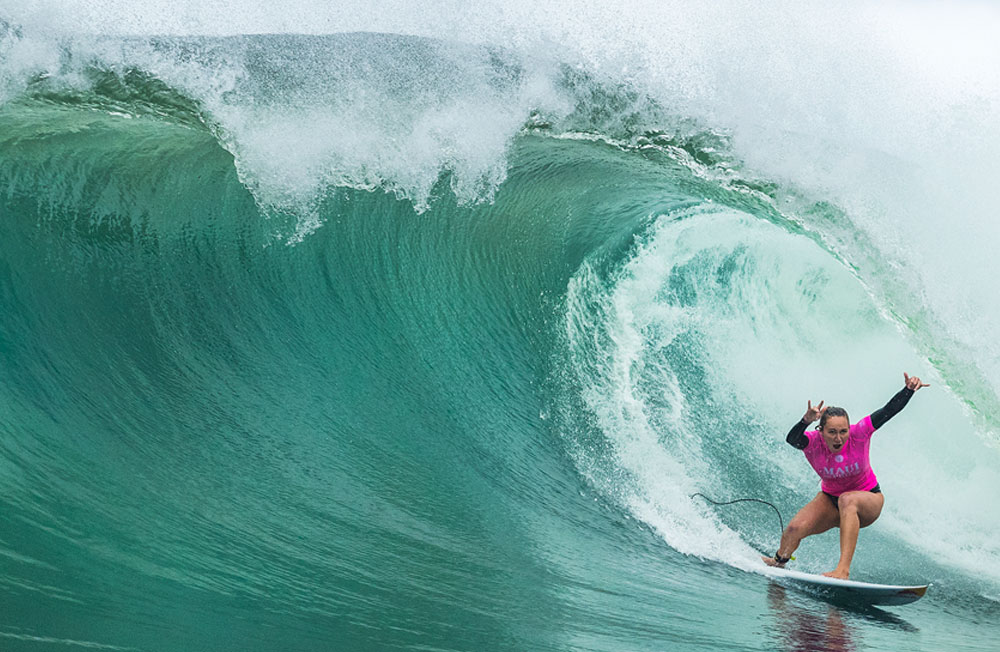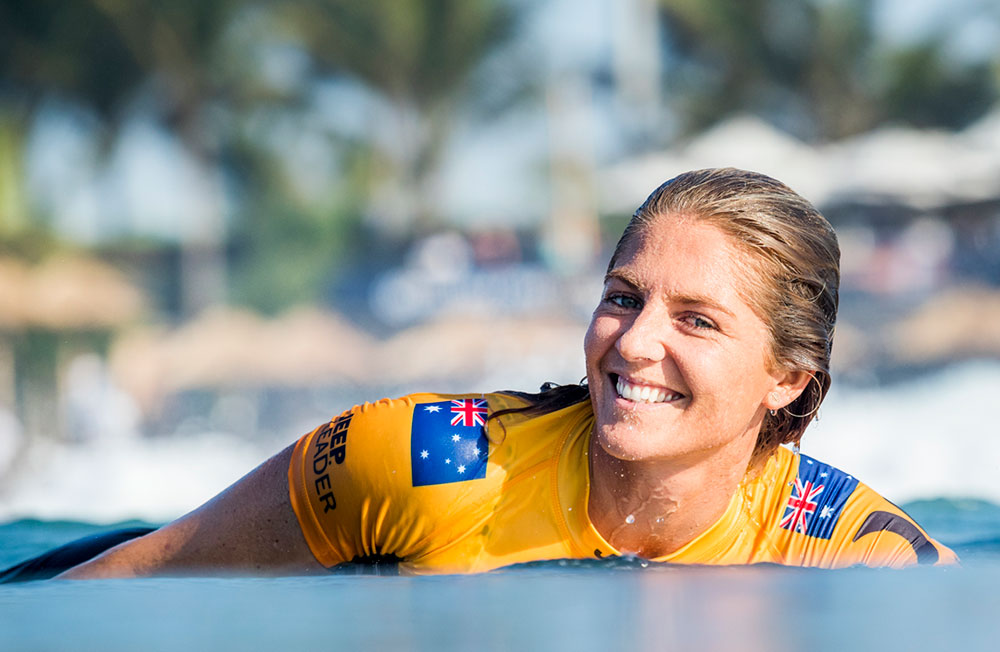Rad News: WSL’s Bringing in Equal Pay!
Boom!
It’s a landmark day for surfing today. The WSL has announced their schedule for the 2019 Championship Tour season, and included in those future plans is the giant news that from 2019 onwards, the WSL will award equal prize money for men and women surfers for “every WSL-controlled event in the 2019 season and beyond”. The press release also stated that surfing was now “the first and only US based global sports league, and among the first internationally, to achieve prize money equality”.
Huge, awesome, overdue news.
WSL CEO Sophie Goldschmidt was quoted in the announcement, saying:
“This change is simply the right thing to do for the WSL and we would like to thank the many advocates who have worked for decades to help advance women’s surfing. We want to be at the forefront of pushing for equality in all walks of life, starting on the waves, and we feel very lucky to have women on our tour who are highly talented, iconic role models, and more than deserve this recognition as they stand alongside our extraordinary male athletes.”
Our six time World Champ Stephanie Gilmore was also quoted, saying:
“This is incredible, and I am thrilled. The prize money is fantastic, but the message means even more.”
“The prize money is fantastic, but the message means even more.” – Stephanie Gilmore
Equal by Nature. From 2019, female and male athletes will receive equal prize money across all WSL controlled events. #CatchThisWave pic.twitter.com/oG7vVAru8J
— World Surf League (@wsl) September 5, 2018
THE VIRAL STORM THAT GOT US HERE
This announcement comes two months after the WSL received harsh online criticism following a viral photo of a presentation at the Ballito Billabong Pro Junior, which showed in plain and easy sight the disparities in pro surfing prize money.
Photographed with their cheques were the Under 18 Men’s Winner, Rio Waida, and the Under 18 Women’s Winner, Zoe Steyn. The novelty sizes of the cheque’s helping show Rio’s prize money to be 8000 rand and Zoe’s to be half that, 4000 rand.
What ensued was a viral shitstorm where the loudest and clearest voices came from outside our surf bubble. Articles popped up on the ABC, BBC, The Australian, SMH, the Guardian and many more big and reputable news medias.
Noted Australian feminist writer Clementine Ford shared the Ballito Pro’s post to her Facebook page, asking: “Did the girls surf on a different ocean? This is bullshit.”
The Ballito Pro was quick to respond to the vitriol by deflecting the blame to the WSL, saying, “The World Surf League is the governing and sanctioning body of the event that determine all prize money and rankings.”

Had Ford and the rest of social media dived just slightly deeper into surfing, in that WSL direction, they would have found even more valid reason to be upset. In the top tier of the WSL, the Championship Tour, there have been pretty big discrepancies too. Pick an event from this year, say, ahhh, the Corona Bali Protected: the male champ Willian Cardoso was awarded $100,000 while his female counterpart, Lakey Peterson, was awarded $65,000 for the same result.
The arguments in support of the pay discrepancy fighting it out in the comments of these articles were numerous and as tired as the women who have to put up with them, and they weren’t really worth paying much attention to: Men being better, audience demand greater, let them surf in one big non-gendered event etc. etc. etc..
But the WSL at the time backed their structure for the prize money gender gap too. Will Hayden Smith from the WSL appeared on Triple J’s Hack to address the issue and explained how prize money has been divided up per-surfer, which shows the pay parity between male and female competitors.
The Hack website put it like this:
“say there are 10 surfers competing for a total pot of $100 in prize money. That works out to a ratio of $10-per-surfer. The winner gets $50, and the runners up get the rest. Now say there is a female competition of five surfers. At the same ratio of $10-per-surfer, the total prize money is $50. The winner gets only $25.”
And it’s that line of thinking that brought us to the WSL’s Championship Tour, where there are 16 regular places for women and 32 for men, and thus a major divide in prize money. The men have to surf more heats and beat more surfers to win an event and so are awarded more money.
There in lied an explanation that mathematically made sense, I guess. But what it did was put a ceiling in place for men’s and women’s surfing set at different heights. It was also a reason for a pay discrepancy that did very little to make things better ultimately. And there was the real problem: It might have been enough, but it wasn’t doing better. And we should want surfing to do the best it possibly can, always. Today the WSL has recognised this, and it feels so bloody good to be typing out that news right now.
THIS IS BIGGER THAN THE CT, AND BIGGER THAN SURFING
Significance should be noted, too, on the detail that this prize money equality is for more than just the very top of the world’s surfing elite.
Says WSL Commissioner Kieran Perrow: “This covers all WSL-controlled events: the Championship Tour, the Longboard Tour, the World Junior Championships and includes the Big Wave Tour starting on October 1st, 2018 to March 2019. We will be working with our partners at competitions where we don’t control prize money, such as certain Qualifying Series events, to achieve equality as soon as possible.”
This takes surfing’s efforts deeper than many other sports with equal prize money at the top end of their sports, like Grand Slam Tennis, and addresses the structures in place that keep sports unequal. The lower ends and junior areas of sport are where discrepancies in prize money create problems in the frameworks of support that allow young athletes to develop, flourish and pursue their dreams, which ultimately leads to greater discrepancies of talent years later at the top end. And that helps the arguments of Joe Dickhead and his friends talking about how prize money at the top reflects the levels of demand and entertainment. It’s a shitty cycle.
The irony of the vitriol the WSL received during that viral storm at the end of June, was that the WSL has made great strides for women’s surfing in the past five years, and on a world scale, was one of the best sporting bodies around when it comes to celebrating men’s and women’s surfing equally. Surfing and the WSL could have pointed back, and said things along the lines of very very few sports in the world have equal prize money, and that, in fact, in the context of world sport, surfing actually ranked very well in how much we support and put on a pedestal women’s surfing, but that still wouldn’t make it right. Looking around at a bunch of shitty situations and defending ours as being not as shitty as the others… that’s not a win. And this is something that surfing, with such a good platform of female surfing stars that stand toe to toe with the men when it comes to being presented on the world’s stage, can be a leader in. We could win at this.

And we could win at this by using that external spotlight being put on surfing to ask questions of the institutionalised sexism we’ve come to expect as normal in surfing.
Clementine Ford’s column about this issue at the time of the viral photo summed it up best:
“The impact of sexism on women’s careers is about so much more than legislation and formalised pay grades. … It’s not good enough for large corporations such as Billabong to need the public to point out these obvious inequalities, nor does it reflect well on the general make-up of those institutions that discrimination like this is seen as so standard that literally no-one thinks to challenge it.”
Surfing got challenged this year, in a big way. And the way the WSL has responded is absolutely wonderful (and it’s time for the rest of us, surfing magazines included, to follow suit).
There is another Steph Gilmore quote from today’s announcement that is worth ruminating on:
“I hope this serves as a model for other sports, global organisations and society as a whole.”
In that quote belies one of the most exciting parts of this: thanks to the WSL today, surfing is now a world leader in this movement. As a community of surfers, that’s something we can be really proud of.
